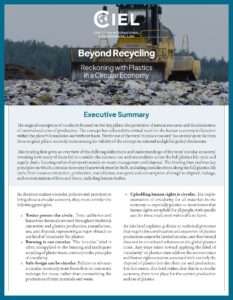
As the world considers how to address the growing impacts of the triple planetary crises of pollution, climate change, and biodiversity loss, many discussions point toward a circular economy approach as a much-needed solutions pathway. The term circular economy is routinely used in conversations and policy discussions that center on re-envisioning the full system of plastics, and is increasingly becoming a popular topic in public discourse. However, there is ongoing confusion about the exact meaning of the term and its application in this context.
The original concept termed circular economy focused on two key pillars: the protection of natural resources and the elimination of externalized costs of production. Over time, however, the use of the term ‘circular economy’ has strayed quite far from these original pillars, seriously undermining the validity of the concept in national and global policy discussions.
Beyond Recycling: Reckoning with Plastics in a Circular Economy first gives an overview of the differing definitions and understandings of the ‘circular economy,’ revealing how many of them fail to consider the resource use and externalities across the full plastics life cycle and supply chain, focusing rather disproportionately on waste management and disposal. The brief then outlines the following key principles on which a circular economy framework must be built:
- Toxics poison the circle. Toxic additives and hazardous chemicals are used throughout feedstock extraction and plastics production, manufacture, use, and disposal, representing a major obstacle to any kind of ‘circularity’ for plastics.
- Burning is not circular. The ‘circular’ label is often misapplied to the burning and inadequate recycling of plastic waste, contrary to the principles of circularity.
- Safe design can be circular. Policies to advance a circular economy must focus first on non-toxic redesign for reuse, rather than normalizing the production of toxic materials and waste.
- Upholding human rights is circular. The implementation of circularity for all materials in the economy — especially plastics — must ensure that human rights are upheld for all people, with specific care for those made most vulnerable to harm.
The brief concludes with recommendations to guide policymakers in returning to the initial intent of circularity and abandoning concepts often erroneously pushed as part of a circular economy.
Read the brief.
Read the one-pager.
Published on March 21st, 2023
